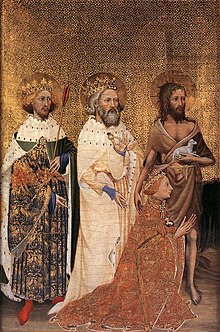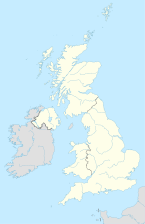Hoxne
| coat of arms | map | |
|---|---|---|
 Coat of arms is missing |
|
|
| Basic data | ||
| District : | Mid Suffolk | |
| Geographic location : | 52 ° 20 '40 " N , 1 ° 12' 1" E | |
| Height : | 33 NN | |
| Area : | 50.25 km² (ward) | |
| Residents : | 1.932 | |
| Population density : | 38.44 inhabitants per km² (ward) | |
Hoxne [ ˈhɔksn̩ ] is a parish (parish) and a district (ward) in the north of the English county of Suffolk in the District of Mid Suffolk . The place Hoxne is about a kilometer south of the river Waveney, which forms the border with Norfolk . In the 2001 census, 813 inhabitants were determined for the municipality and 1,932 for the district of Hoxne.
history
The area around Hoxne was already settled in the Paleolithic . Finds of stone tools made by John Frere (1740–1807), a pioneer of prehistoric research in 1797 and which he reported in a letter to the Society of Antiquaries of London , bear witness to this. When the significance of the finds became apparent about 100 years after the find, the warm period known in Germany as the Holstein warm period was referred to as the Hoxnian Interglacial in Great Britain .
On November 16, 1992, a treasure from Roman times known as the Hoxne Depot Find was found . It contains over 15,000 gold and silver coins, gold jewelry and various pieces of silver tableware, including pepper shakers and over 100 ladles and spoons. The youngest coin of the hoard was minted in 407/08. A year earlier, the last Roman troops had left the island to protect the endangered Rhine border of the Roman Empire. The places on the island now had to defend themselves. Possibly in the course of this political upheaval, the hoard was hidden.

After the Anglo-Saxon settlement, the area of Hoxne became part of the Empire of East Anglia . In November 869 there was the battle of the same name in Hoxne, in which King Edmund of East Anglia was defeated and killed by a Danish Viking army . All of East Anglia then lost its political independence and became part of the Danelag . In the following years a martyr cult developed around Edmund. Coins calling him a martyr were minted as early as 890. Edmund himself is buried in Bury St Edmunds .
Attractions
There is a pub in town called Swann Inn in a building previously known as Bishops Lodge. The Bishop of Norwich had this house built around 1480.
A stone cross, the St Edmunds Memorial, was erected south of the village in memory of Edmund the Martyr.
The church dedicated to St. Peter and St. Paul stands on the northern edge of Hoxne.
education
The Hoxne St Edmunds Primary School is located south of the town center.
Local politics
The Hoxne municipal council has eleven members. The current MP is Sir Michael Lord ( Conservative Party ).
Individual evidence
- ↑ Bill Bryson : A Brief History of Everyday Things. Goldmann Verlag, Munich 2013, ISBN 978-3-442-15755-6 , p. 556.
Web links
- The British Museum: The Hoxne Hoard (English)
- Homepage of Hoxne (English)
- Suffolk Churches: St Peter and St Paul (English)
- extensive collection of links to Hoxne (English)

